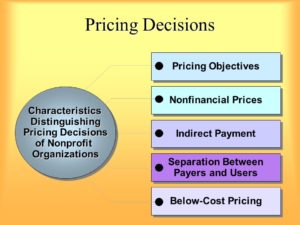Recipient product range can be expanded to include new can related services. Universities may offer evening courses health care centers may offer well woman screening services. Benefits offered to sponsor/client segments may be updated to include newsletters and magazines in return for subscriptions affinity credit cards gift catalogs or personal gifts and awards. Product differentiation can be another useful strategy in not-for-profit marketing.
Organizations can seek to differentiate their product or service from that of the competition. Schools and colleges may offer special facilities or areas of excellence (for example in sports) which can help to distinguish them from the competition.
Health clinics and hospitals may introduce upgraded rooms and offer restaurant-style menus of top-class cuisine.
The product life cycle concept applies to services in the ngo consultancy sector just as much as to products and services in commercial markets. Services can become outdated as new services are developed ant part of the product management task is to monitor service performance and demand trends. New services need to be developed and introduced at the right times and services which are no longer efficient or for which demand is declining should be phased out.
PRICING DECISIONS
Pricing is a complex issue in not-for-profit organizations. Very often the organization exists to provide its services free of charge to its client/recipient market. In organizations which operate fee structures which are more closely aligned to commercial enterprises fees must be set at a level which will cover costs (or costs fewer subsidies) and provide enough revenue for service levels to be maintained or to grow. There are a number of elements to the price issue of the marketing mix which do not relate solely to price setting. These include:
(a) Method of payment
(b) Credit terms
(c) Payment frequency
(d) Sliding scales
All first glance it may seem that these do not apply to organizations in the not-for-profit sector.
However, it is worth considering each of these in turn as they cover some important issues Method of payment In sponsor/contributor markets payment methods available can help to influence levels of support.
Market research may identify segments of this market who may be more willing to pay (or to pay more) by some direct means such as standing order. methods of payment can attract tax benefits, either for them or the organization.
Deeds of the covenant where money is paid a contractual basis over asset period attract income tax relief is paid to the organization on top of the sum contributed.
In a way, the donor can see their money being put to highly effective and they may be encouraged to contribute in this way. Payment does not have to be in the form of cash. 80g registration can be highly compatible with your non -profit -organizations.
Companies can be approached to provide goods or services ranging from products to auctioned to raise funds for example to providing expertise and. Providing products or sponsoring the purchase of certain items such as football strips for local teams) can bring benefits in terms of favorable publicity. Again, thorough research into the sponsor markets should identify these kinds of opportunities.
Clubs may allow membership fees to be paid over long periods colleges may arrange credit schemes to spread the cost of tuition. Credit cards may be accepted both in payment for their service end in making donations.
These aspects need careful consideration. Payment frequency addressing the sponsor/contributor market organizations need to consider how they can most successfully achieve their objectives will single one-off payments result in more revenue than steady smaller sums? There are many reasons why it can be preferable to receive slow steady payments rather than ad-hoc injections. encouraging contributors to make regular payments (through one of the direct payment methods available makes strategic sense. Subscriptions may be elicited perhaps in return for newsletters or membership benefits.
Friends of schemes are used by many organizations where subscribers pay a modest fee to become a friend. In return, they may be invited to participate in social events or receive discounts on standard ticket prices. Membership subscriptions may also be paid by clients especially in relation to clubs and associations.
These may be due weekly monthly or annually. In all these cases care must be taken to select the payment frequency most likely to be accepted both by contributors and users. Sliding scales Charges for services in the NGO sector can be based on sliding scales related to individual ability to pay. Membership or subscription fees for contributors can be similarly designed with reductions for pensioners and students for example.



